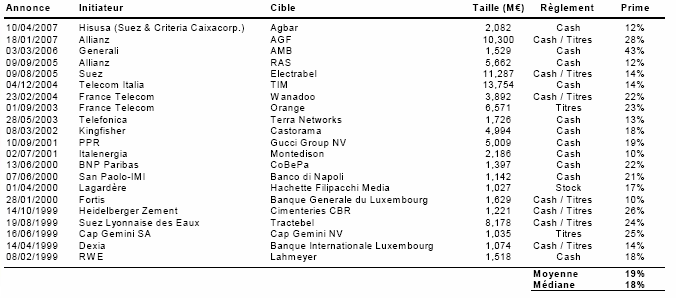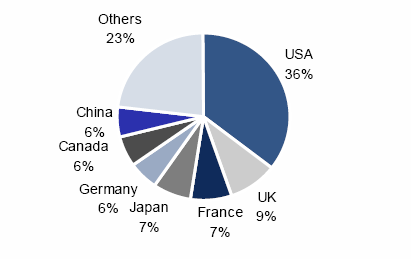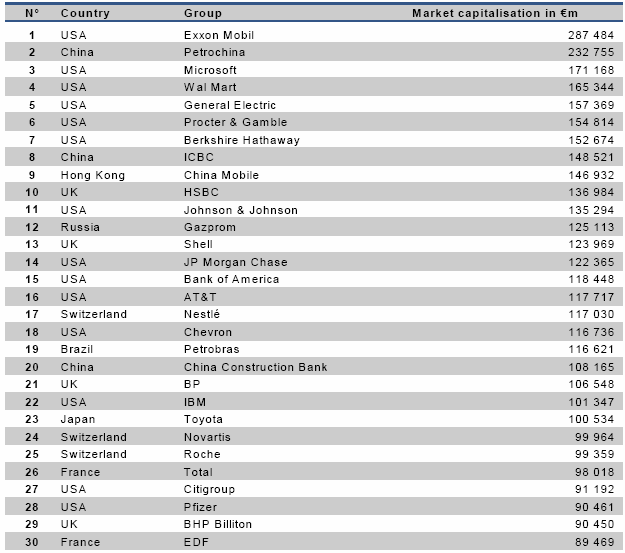Letter number 35 of October 2008
ALL ARTICLES
- TOPIC
- STATISTICS
- RESEARCH
- QUESTIONS & COMMENTS
News : The death of the minority discount
The Société Française des Evaluateurs (SFEV), the French association that covers practically all professionals involved in business valuation, took an inspired decision to set up a working group made up of some of its members and chaired by Sonia Bonnet-Bernard, to study premiums and discounts in the field of financial valuations.
We set out the main points raised in their research, focussing on minority discounts. Based on our own experience and on the conceptual work of corporate finance researchers, we have long been convinced that there was something almost mediaeval about minority discounts. The SFEV report confirms this in no uncertain terms: “In our view, minority discounts do not appear to be justified”.
Three examples serve to illustrate this point of view:
• When a group wishes to buy up the shares held by minority shareholders in one of its listed subsidiaries, in which the group has a controlling interest that exceeds 50%, the average premium is will be required to pay in Europe is around 18% (1). Allianz, for example, had to pay a premium of 28% on AGF’s average monthly share price in order to buy up all of the shares that it did not already hold. So what’s all of this talk about a minority discount?
• A shareholder with a 20% stake in a family-owned company of which he also happened to be the general manager decided to sell his shares. All of the financial investors and trade players he approached has already received a visit from the majority shareholders, who had threatened to make a misery of the life of any foolish investor who dared to buy the minority stake. After three years, and because he needed to cash-in, the minority shareholder sold his stake at less than 30% of its value to the only buyer on the market, ie, the majority family-shareholder. Did you say minority discount? 70% isn’t a discount, it’s a fire sale!
• Three brothers each held a 17% stake in an industrial group. One of them wanted to sell his shares, but he no longer got along very well with his brothers. Both he and the industrial group were able to exit the capital without granting a discount at all, as the two remaining brothers, afraid of becoming minority shareholders, bought their shares at a little more than their market value, without even haggling. Not exactly a minority discount is it?
In other words, a minority discount, when it is granted, is merely the result of a power play between a seller who, for various reasons wishes to sell, and a buyer, who knows he is the only party in a position to buy and who intends to take full advantage of this position. You can now see why we used the word "mediaeval" earlier on. A minority discount makes no sense when the minority shareholder is reluctant or does not wish to sell and the majority shareholder wants to buy. In this situation what we see are premiums being paid (as in the Allianz example above).
What we should be referring to more accurately here is a liquidity or an illiquidity discount. Because the minority shareholder wishes to liquidate his stake, he may be forced, if he's in a poor position to negotiate, to make do with whatever the majority shareholder is prepared to offer. If the general manager in our third example had been able to hold out for a bit longer, he would have been able to sell his stake alongside the family and taken a share of the control premium when the family sold a controlling interest in the company four years later.
Recent events have shown that turning shares into cash can sometimes be a very costly business (Bear Stearns). Accordingly, it is very difficult to put a figure on a liquidity discount, even if rationally it can be compared to an IPO discount that penalises shareholders wanting to liquidate their shares and is usually around 15% on average (2). However, the above examples show the limitations of the idea of “average”.
The SFEV working group rightly draws attention to the fact that from a rational point of view, there is no justification for the minority discount:
• Given that the discounted free cash flow (DCF) is usually calculated on the basis of the CAPM (3), it is based on stock market prices, which means marginal trades, which means trades by minority shareholders. So, there is no point in discounting the value as well since the discount rate already takes into account the fact that the stake is a minority stake
(1) On average since 1999 for share acquisitions exceeding €1bn (excluding compulsory offers and mergers).
(2) For more information, see chapter 40 of the Vernimmen.
(3) For more information, see chapter 22 of the Vernimmen.
Research : Loan syndication
The last 20 years have seen the spectacular development of syndicated loans in Europe, where their share of total bank loans granted rose from less than 1% in 1990 to 36% in 2005 (1). In another recent study, C.J. Godlewski (2) explains this phenomenon by setting out the advantages offered by this type of loan, for both the lender and the borrower. He shows how certain types of borrowers in certain market environments are more likely to go for syndicated loans.
Traditionally, lenders have seen the key advantage of syndication as greater diversification of risk. The author shows that loans for large amounts are syndicated more often than for smaller amounts, which seems to confirm risk diversification as a motivating factor. Syndication enables banks with limited lending capacity to take part in transactions from which they would otherwise be excluded.
From the borrower’s point of view, syndication provides access to relatively cheap financing for large loans. Godlewski shows that the potential for banking syndication is reduced on developed financial markets. This is especially true of the bond market on which it is also possible to diversify risk - the bond market is in fact in competition with loan syndication.
The drawbacks of syndication are mainly agency issues. Firstly there is the issue of adverse selection. Given that the lead bank only assumes a part of the risk, it may tend to syndicate loans of mediocre quality, its chief concern being to collect the commissions on the loans. The availability of public information on the loan (rating by ratings agency) does not have a substantial impact on the decision to syndicate a loan. It would appear that public information is replaced by private information provided by the lead bank, which is obviously keen to maintain its reputation. Accordingly, adverse selection is not really an issue.
Another agency-related issue is moral hazard. The lead bank exercises control over the borrower on behalf of all of the banks in the syndicate. Any exposure of the lead bank could result in a weakening of its control. In Leveraged Buy Outs, loans have a 10% greater chance of being syndicated than in other transactions. On this type of transaction, the lead bank also acts as advisor to the borrower which means that the moral hazard risk is reduced when a loan is syndicated.
Generally, the spectacular increase in the number of syndicated loans is explained by the improvement in valuation and loan pricing techniques by banks. In his article, Godlewski sums up the pros and cons of syndicated loans, which have now become common practice.
(1) See the Vernimmen page 626 for a description of the syndication process
(2) C. Godlewski (November – December 2007), Les Déterminants de la décision de syndication bancaire en France, Banque & Marchés, n°91.
Q&A : What are Monoliners?
by Estelle Ruiz, BNP Paribas –Group Risk Management
Monoliners are insurance companies which provide financial markets’ operators with credit enhancement.
Financial guaranty insurance is acknowledged to have begun in 1971 with the insurance of a $650,000 obligation bond in Alaska. The first time a guarantee was called was in 1983 when the Washington Public Power Supply System defaulted on its debt repayments: uninsured bondholders suffered losses; insured ones were paid out in full and on time.
Insurance of repayment of third-party debt is the only type of risk monoliners can take. They have no other insurance business lines that could jeopardize the safety of the financial guarantee they provide. Monoliners also limit their exposure to individual issuers under the assumption that any issuer can default. By adhering to an investment grade standard and focusing on credits with the lowest probable risk of default, the insurers could potentially minimize their claims experience. Historically, these restrictive business policies earn monoliners typically an AAA-rating.
Monoliners have long provided guarantees to the municipal bond and securitization market. The AAA-monoliner “wraps” its own credit rating around a debt obligation in exchange for an unconditional and irrevocable guarantee of scheduled principal and interest payments on insured bonds, enabling issuers to achieve debt ratings above their stand-alone underlying rating. It results in reduced borrowing costs and broader market distribution.
But monoliners have also become major counterparties in financial institutions’ structured credit activities – in particular, providing credit enhancement on residential mortgage-backed securities and collateralised debt obligations of asset-backed securities (CDOs of ABSs) through credit default swaps (CDSs).
The foray from traditionally safe municipal bond guarantee business into structured finance underwriting was driven by increasingly competitive industry conditions and tight credit spreads that reduced the potential premium income in their traditional municipal business line over the 1990s. By 1999 the new volume of more remuneratively insured asset-backed securities (ABS) for the first time exceeded that of insured municipalities.
Monoliners are highly exposed to the US market as US obligations amount for 86% of the obligations they cover, and 50% of US municipal bonds are guaranteed by monoliners. Moreover, with around $250bn related to US RMBS and CDOs of ABSs, monoliners are highly exposed to the US sub-prime mortgage sector.
Operating on the assumption that sufficient subordination through the capital structure of transactions made losses to super-senior tranches virtually impossible, monoliners have not been required to post collateral on the polices they write. However, the sub-prime fallout has hit the value of those securities hard. This has brought into focus flaws in the “zero losses” assumptions used in the monoliners’ business model. With credit deterioration in sub-prime portfolios making losses increasingly likely, most exposed monoliners, with their traditionally high operating leverage (i.e., net par outstanding-to-total claims paying resources) are not sufficiently capitalised to meet those claims. As a consequence, they have no choice but injecting equity in order to comply with regulatory constraints and maintain their external rating as credit enhancement’s capability depends on their AAA-rating.
The potential impact of the decline in credit quality of monoline insurers on banks can be seen in two cases:
• in the first case, banks incur appraisal losses or realized losses due to the decline in the market value of financial products guaranteed by a monoline insurance company,
• in the second case, banks that purchased protection from monoline insurance companies based on credit default swap (CDS) contracts to hedge investment risks incur costs such as provisions due to the deterioration of the insurers’ credit quality. Notably, the degree of impact of the insurance companies’ credit risks increases in proportion to the degree of deterioration in the value of the reference obligation.
In response to the decline in their credit quality, banks are becoming more wary about opening trading/credit lines with monoliners, as well as being cautious about entering into trades with banks that have exposure to these guarantors.
Composition of insured portfolios:
Municipal Bond Insurance: according to Fitch, around 50-60% of the bigger guarantors’ insured portfolio, or $1.2trillion, consists of municipal bond insurance (including international public finance projects).
RMBS, CDO of ABS, CLOs: the remaining $1.2trillion represents international and structured finance insurance. Barclays Capital estimates that banks’ total holdings of structured securities enhanced and hedged with insurers amounts to $820bn. According to S&P, the industry guaranteed $127 billion of collateralized debt obligations (CDO) linked to sub-prime mortgages.
CDS: the composition of underlying reference entities is dominated by corporate credit, which represented 62% of total CDS exposure at year-end 2006, or $287bn. RMBS were the second largest component of underlying reference entities representing 14% of the total, or $65bn.



